The African Burial Ground of NYC
New York City’s African Burial Ground National Monument has an interesting history. Or, rather, two histories: one of the people who were buried there, the other of the rediscovery of the graveyard and the establishment of this monument.
Disclosure: This article contains an affiliate link. If you click on it and spend money, I will receive a small commission. This will not affect your price.
Rediscovery of the African Burial Ground
In the process of preparing a building lot for a new federal building in Manhattan back in 1991, builders came upon a number of graves. The discovery led to strong protests at the disturbance of this sacred ground. Work stopped in order to allow investigation of the finds, which was carried out at the Cobb Laboratory, a research institute at Howard University.
Through their research, scientist were able to determine in great detail the health and age of the 419 remains that were dug up from about an acre of the burial ground. The burial ground was originally, as evidenced by a map dating to 1755, more than six acres in size, so there were (are!) undoubtedly many more graves hidden under neighboring buildings.
Once the archeological investigation was concluded, the remains were reburied in 2003 using caskets from Ghana, and marked by West African funeral rites. The African Burial Ground National Monument was established on the ground floor of the newly-built Ted Weiss Federal Building.
Africans in colonial New York City
Africans were kidnapped from many parts of Africa and brought to this city as early as 1626. They worked in many different roles: clearing land, building, working in homes as servants, doing laundry, and so on.
The archeological evidence shows that the Africans buried here were often malnourished and overworked. Many died from diseases like smallpox and yellow fever, not to mention outright violence. There was a high rate of infant and child mortality among the enslaved population as well.
When they died, they were not allowed to be buried in the city’s cemetery, so instead a plot of more than six acres was allocated outside the city limits for an African burial ground, though, of course, the city expanded quickly to encompass that land.
Despite their poverty, the community—consisting of both enslaved and some free blacks—buried their dead in a dignified way, in caskets with the head facing west. Some were buried with objects such as jewelry, buttons or shells. The burial ground was in use until the 1790s, when the land was divided up and sold for building lots.
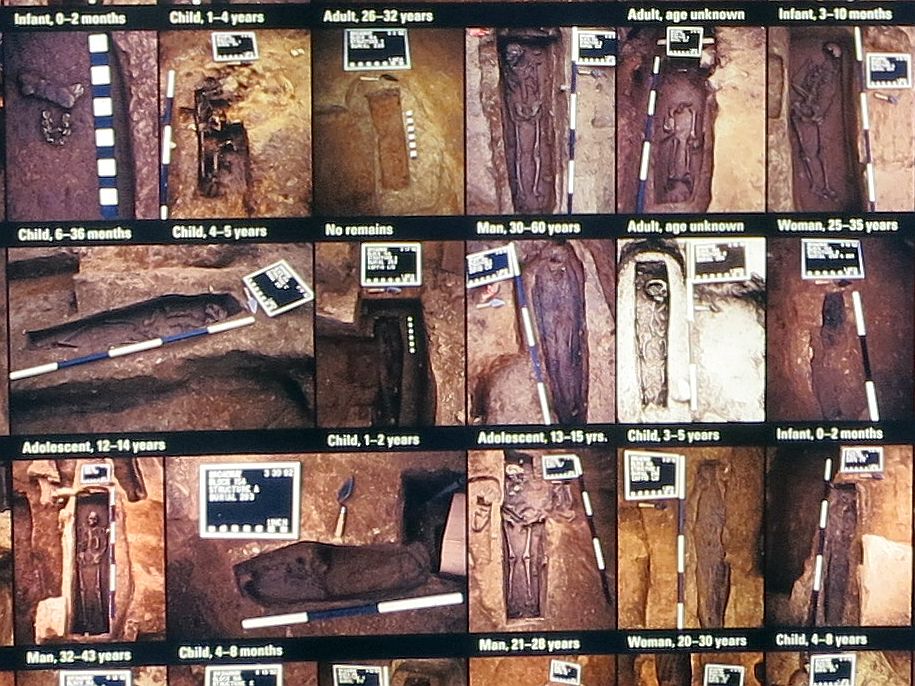
To learn more about the starting point of the slave trade, read my article about my visit to Badagry, Nigeria, one of the “points of no return” for captive Africans.
For more ideas of things to see in New York City, check out my article “New York City on a Budget: Free or cheap things to do“!
Visiting the African Burial Ground National Monument
The very low-key entrance next to the main lobby of the federal building leads first to a security check. This is a federal building, after all, and they can’t just let people walk in freely. The security guards scanned my bag and I had to pass through a metal detector, but they were very friendly. Since it’s a National Monument, admission is free.
The museum inside tells the two parts of the story: about the community that used this burial ground in the 17th and 18th centuries, and about events in the 20th to 21st century: its rediscovery, the protests, the research, and the reburial.
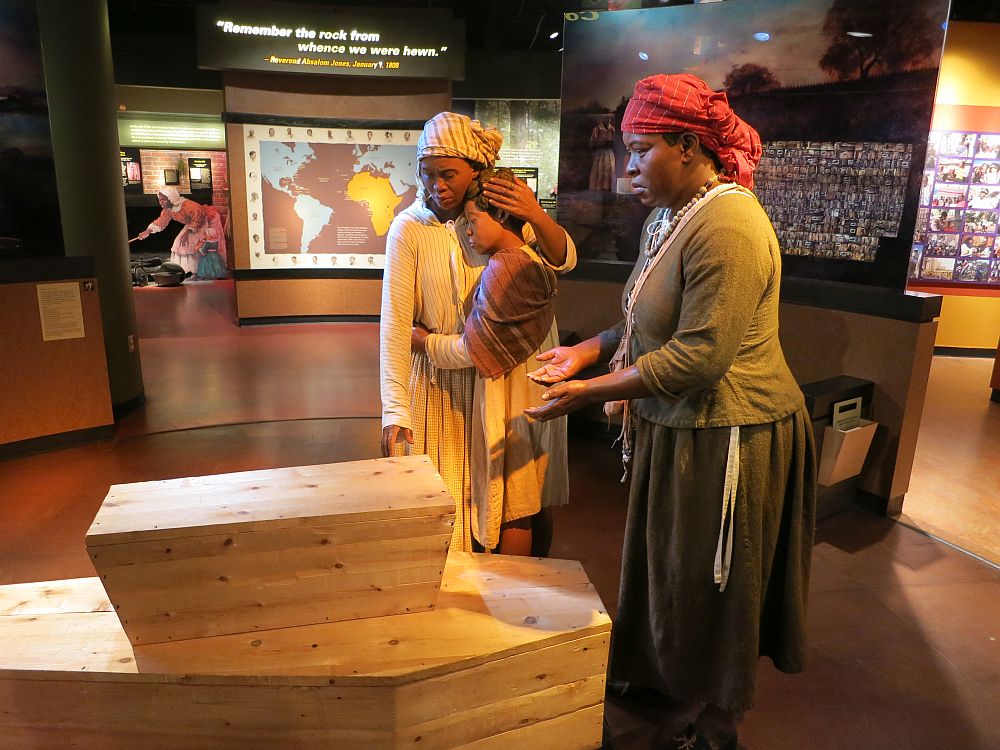
This museum is unusual in that nothing that is displayed is actually authentic. Instead, it tells the story of the people who were buried here and what their lives were like, as revealed by the detailed research on their bones.
Items found in the graves, small things like buttons or jewelry, were also reburied with the bodies. Copies are on display in the museum.
Videos and photos show the ceremonies surrounding the reburial in 2003.
Planning a stay in New York City? Use this link to book accommodations.
Outside the African Burial Ground
Exiting the museum, I walked into the lobby of the federal building to check out the artworks exhibited there. All are related to the African Burial Ground in some way. A casket like the ones in which the bodies were reburied is also displayed.

Beside the building outside stands a memorial to the people buried there. It’s lovely and stark at the same time. First I walked through a dramatic triangular marble structure called the Ancestral Libation Chamber. Its smooth, shiny walls slant inwards, but with an opening to the sky overhead.
The pamphlet visitors receive at the entrance describes this as representing:
…the soaring African spirit and the distance below the ground’s surface where the ancestral remains were rediscovered. . . . Reminiscent of a ship’s hold, the interior is a spiritual place for individual contemplation, reflection, and meditation.
Next, I entered a sunken, perfectly circular space, called the Circle of the Diaspora. A map, engraved in the floor, refers to some of the individuals, not by name, but with phrases like “Burial 210 – man between thirty-five and forty-five years” and “Burial 284 – man between twenty-one and twenty-eight years.” On the walls surrounding the space, symbols are carved that originate in different parts of the African diaspora.
Nearby are a series of seven grass-covered mounds, marking where the bones were reburied in caskets inside seven crypts.
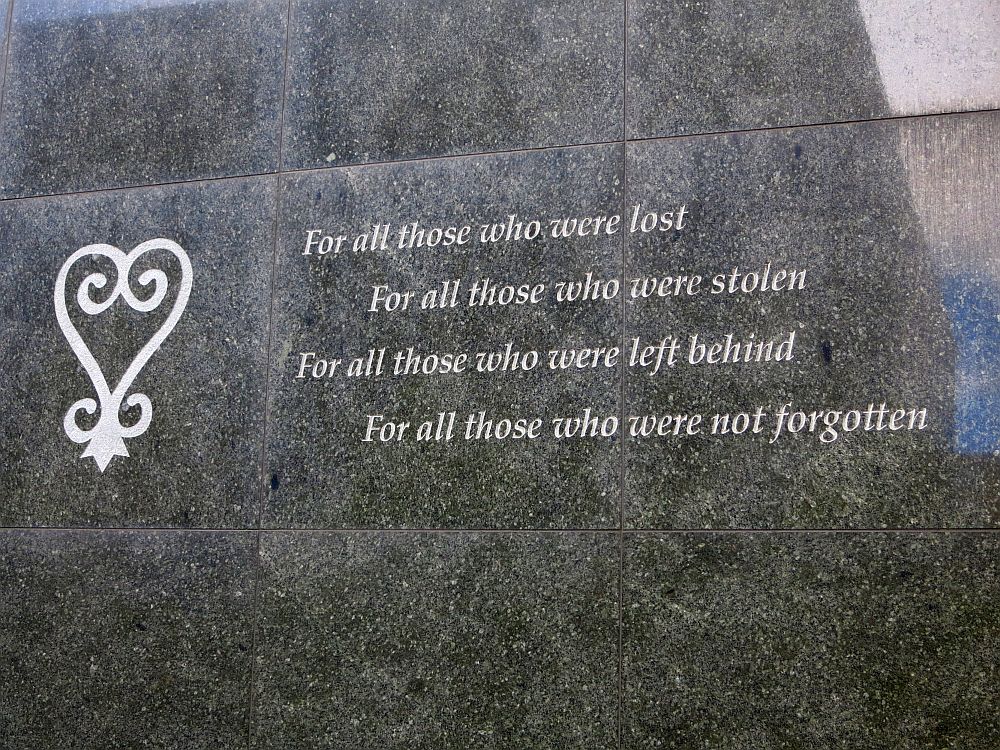
The African Burial Ground National Monument was not at all what I expected going in. I found it fascinating, though, to learn how much detail scientists managed to discover about the lives of these people.
After all, they hadn’t just been buried in a cemetery, but literally covered up by buildings: erased from the history of the city until they were inadvertently revealed. This museum and monument is a respectful acknowledgement of their existence and dignity.
African Burial Ground National Monument: 290 Broadway, between Duane and Reade Streets. Nearest subway stations: Chambers Street (1,2,3,A,C,J,Z), City Hall (R), or Brooklyn Bridge-City Hall (4,5,6). Open Tuesday-Saturday 10:00-16:00 (Check ahead; as of this update on August 4, 2020, the monument is closed due to Covid-19).
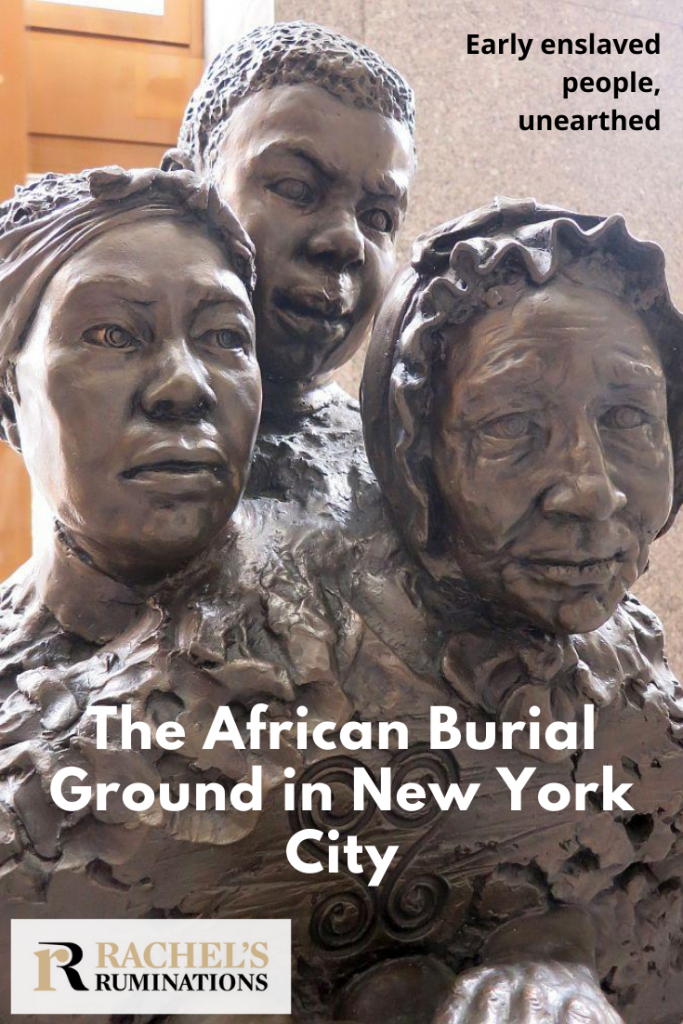


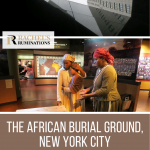
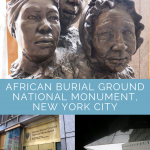
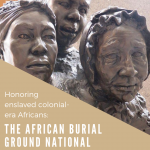
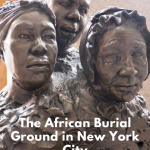
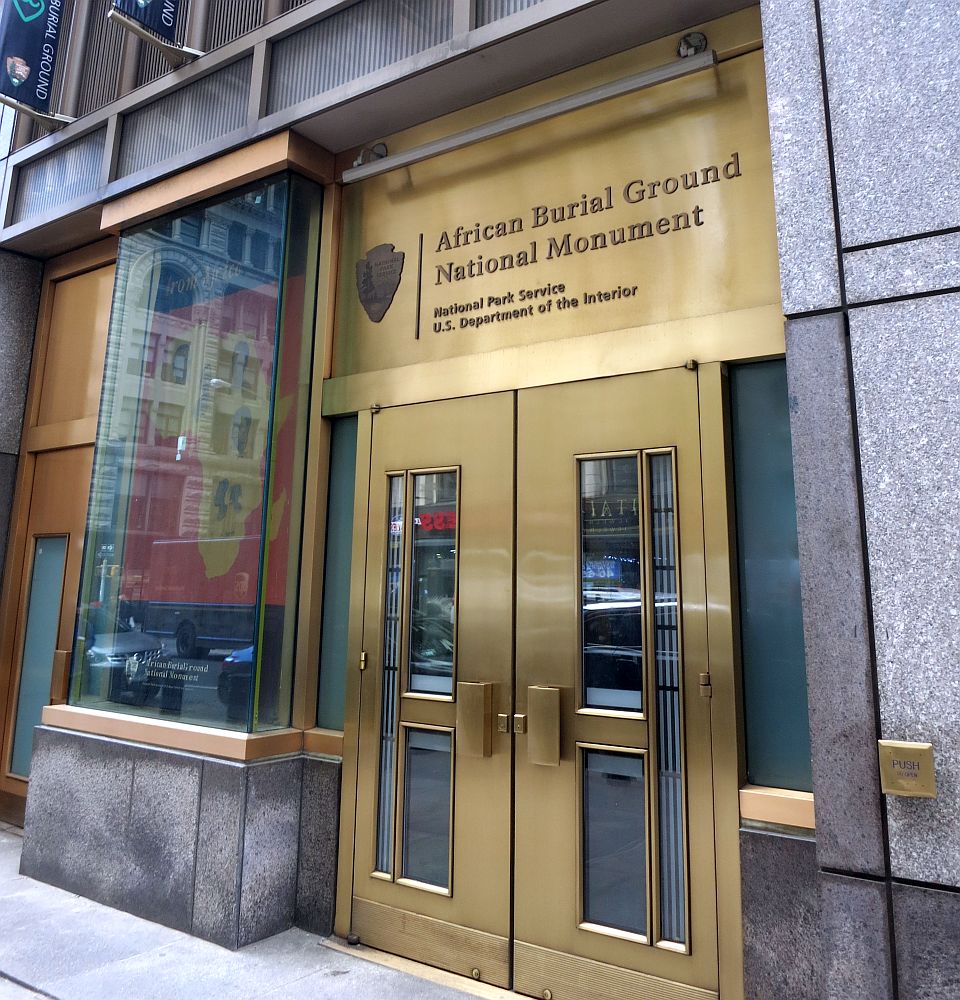
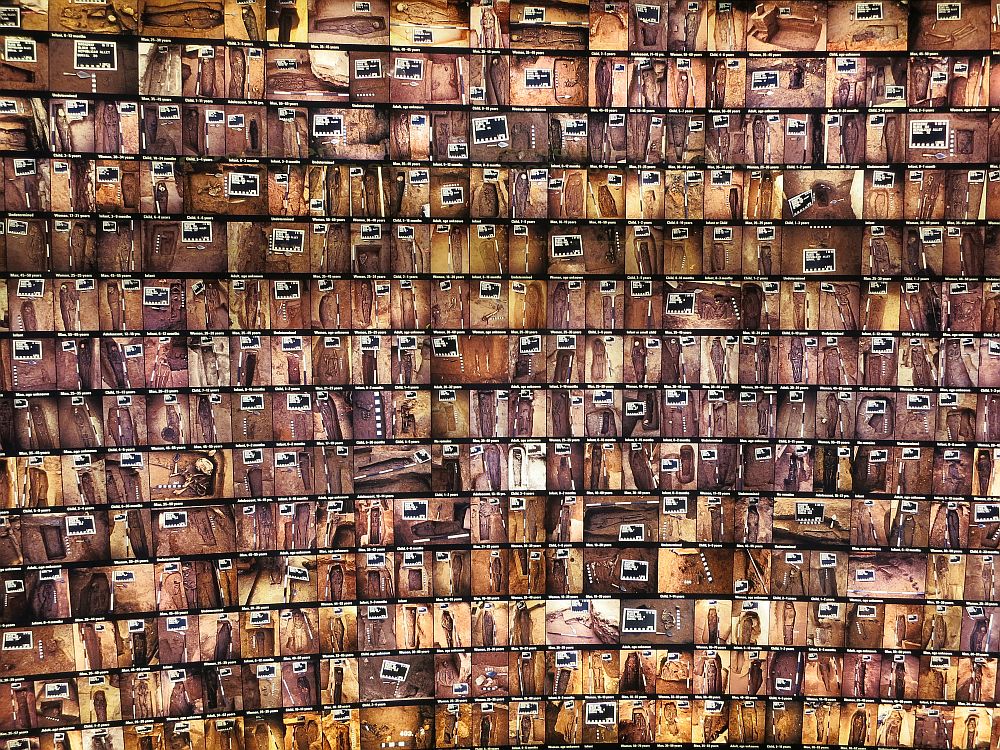
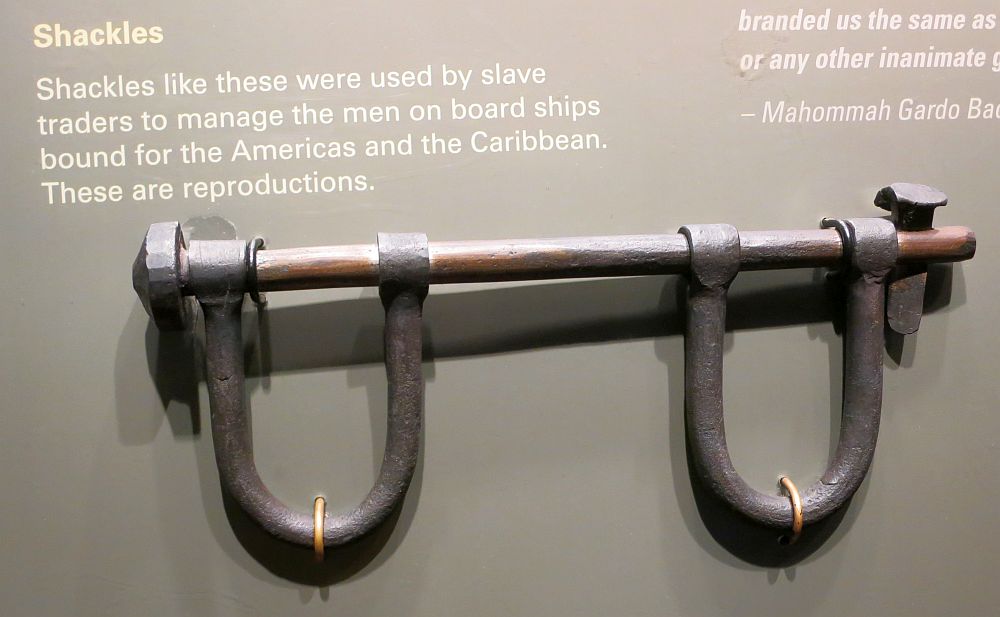
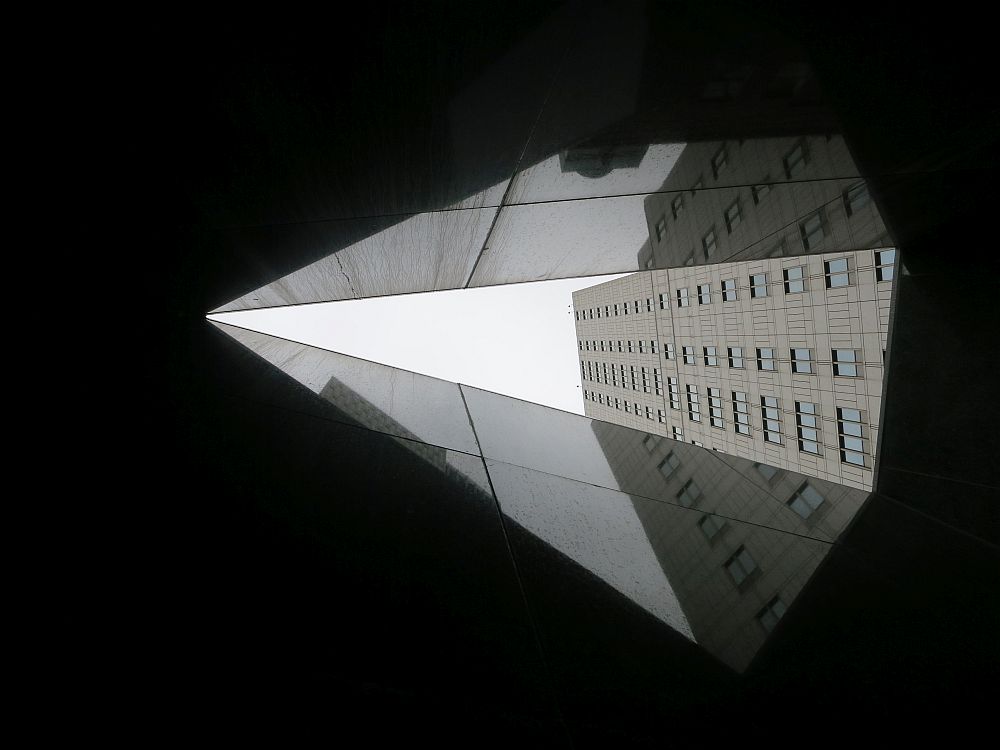

Interesting! I just went to an exhibit in London which talked about the sale of fabric to West Africa in exchange for slaves most, if not all, of whom were destined for the Caribbean and North America. This would have been the back story of these poor unfortunates buried here.
Yes, that back story is detailed in this one too. That photo of the shackles was from that section.
That’s a lovely shot of the memorial. It was closed for the winter so I could only see it from the street. I’ll have to remember to check it out in the summer.
I was in DC when the remains were found and sent to Howard to be examined. I was in NY by the time they were reinterred. I remember the months of protests, the halt in construction until the government finally agreed to set aside a portion of the property to create the memorial. Visiting the museum was educational but emotionally wearing.
The whole battle to create the memorial is documented in the museum as well. Yes, it can be emotional, which is an achievement when you realize that almost everything in the museum is not original. It’s also quite a small space, in which they tell quite a lot: the history of the slave trade to the Americas, the lives of the slaves who lived in NYC, how they buried their dead, how the graves were excavated, how the remains were studied, the battle to get the museum, the politics about reburial, the reburial ceremony itself. In essentially one big room!
When I was a kid, I was forever worried that our house had been built on an ancient Native American burial ground. I’m glad that whoever discovered these graves had the respect to pause what I’m sure was a very costly project to allow everything to be exhumed. I am even more impressed that they would create an entire museum out of it. That Ancestral Libation Chamber seems claustrophobic, so I suppose it’s doing a good job of conveying what a slave ship feels like inside.
I gathered from the exhibits that getting the remains investigated and treated with respect involved a big political battle, as well as getting the government to give space in and outside the building for a museum and memorial. It didn’t happen without a fight!
This was really interesting and wish I had known about it when I was in NYC two weeks ago. I love learning a bit of history when I travel and from the pictures you showed, they did a great job of recreating the story.
There’s always next time! Yes, they did a great job!
Love your post! Places like this are the interesting and unique tidbits one can discover when you spend more time in a city (or ask a local). Who would have thought such a place exists among the glittering highrise facades of NYC?
Thanks! Yes, from the outside it looks like just another high-rise office building among many.
Ohhh – that’s heavy, in a good way. It’s good to find a museum such as this being represented. The whole experience must have been quite emotional
Yes and no. Obviously the whole topic is emotional, but it’s all presented using copies, which somehow mutes it. For me the memorial outside was more emotional.
Boggles the mind that people can be buried, and then can literally end up in someone’s basement. I love the skylight in the libation chamber. It’s also heartening to see that these people are remembered.
Either they’re still there, under neighboring buildings, or they were dug up long ago when they built the foundations.
That skylight isn’t a skylight: it’s open to the sky.
Had no idea about the African Burial Ground Monument, but we will certainly be visiting this on one of our visits to the city. Thanks!
I’d love to hear what you think of it!
You’re quite welcome!
Thanks for introducing me to this historic gem!
You’re quite welcome!
New York has so many interesting smaller museums. Great that people of this burial ground are now having their stories remembered.
Yes, it is! I love visiting small, less well-known museums. If you click above on ‘other topics’ and then choose museums, you’ll see the whole list since I started writing on this blog regularly.
Fascinating history. I am glad it was not just paved over. I just did a walking tour of Rome and wondered the same thing. The tour guide said that so many civilizations are buried that it was evident that prior cultures just built on top of existing ones.
I guess it happens everywhere! There’s a difference, though, between building on it and forgetting it!
I remember a school text book which had a plan of a slave ship in it – it really brought home the grim reality of the slave trade. I’m glad that memorials like this give some recognition, however belated, to the people involved.
So am I. I always use one of those diagrams to teach about the slave trade. I stop and talk them through imagining what it was like: the fear, the smells, the physical and psychological pain. This is also covered in the museum.